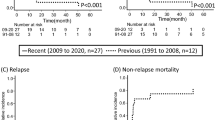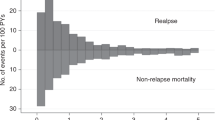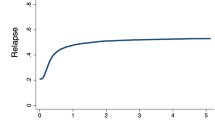Abstract
Allogeneic hematopoietic cell transplantation (HCT) is the treatment of choice for high-risk myeloid and lymphoid leukemias. Relapse after allogeneic HCT is associated with a dismal prognosis and further therapeutic options are limited. One potential curative approach is a second allogeneic HCT. However, there is no consensus about optimal transplant modalities, suitable patients, and entities. We performed a retrospective analysis of our institutional database to evaluate risk factors that influence survival after a second allogeneic HCT for the treatment of relapsed acute myeloid leukemia (AML) and acute lymphoblastic leukemia (ALL). We identified 40 patients (AML, n = 29; ALL, n = 11) that received a second allogeneic HCT at our institution. At time of second HCT, 48% of patients were in complete remission (CR). Current overall survival (OS) was 14/40 patients with a median follow-up of 64 months (range 4–140) of patients alive resulting in a Kaplan-Meier estimated 2-year event-free survival (EFS) and OS of 32%, respectively. Cumulative incidence of non-relapse mortality (NRM) and relapse at 2 years was 31 and 37%, respectively. We identified several independent risk factors influencing OS: > 6 months from first to second transplant (p = 0.02), complete remission prior to transplant (p = 0.003), and the subsequent occurrence of chronic graft-versus-host disease (p = 0.003) were associated with a significantly improved OS. In conclusion, our data suggest that a second allogeneic HCT is a curative treatment option for relapsed acute leukemias in selected patients.


Similar content being viewed by others
References
Porter DL, Alyea EP, Antin JH, DeLima M, Estey E, Falkenburg JHF, Hardy N, Kroeger N, Leis J, Levine J, Maloney DG, Peggs K, Rowe JM, Wayne AS, Giralt S, Bishop MR, van Besien K (2010) NCI first international workshop on the biology, prevention, and treatment of relapse after allogeneic hematopoietic stem cell transplantation: report from the committee on treatment of relapse after allogeneic hematopoietic stem cell transplantation. Biol Blood Marrow Transplant 16(11):1467–1503
Pollyea DA, Artz AS, Stock W, Daugherty C, Godley L, Odenike OM, Rich E, Smith SM, Zimmerman T, Zhang Y, Huo D, Larson R, van Besien K (2007) Outcomes of patients with AML and MDS who relapse or progress after reduced intensity allogeneic hematopoietic cell transplantation. Bone Marrow Transplant 40(11):1027–1032
Bosi A, Laszlo D, Labopin M, Reffeirs J, Michallet M, Gluckman E, Alessandrino PE, Locatelli F, Vernant JP, Sierra J, Jouet JP, Frassoni F, for the Acute Leukemia Working Party of the European Blood and Marrow Transplant Group (2001) Second allogeneic bone marrow transplantation in acute leukemia: results of a survey by the European Cooperative Group for Blood and Marrow Transplantation. J Clin Oncol 19(16):3675–3684
Schmid C, Labopin M, Nagler A, Niederwieser D, Castagna L, Tabrizi R, Stadler M, Kuball J, Cornelissen J, Vorlicek J, Socie G, Falda M, Vindelov L, Ljungman P, Jackson G, Kroger N, Rank A, Polge E, Rocha V, Mohty M, on behalf of the Acute Leukaemia Working Party of the European Group for Blood and Marrow Transplantation (EBMT) (2012) Treatment, risk factors, and outcome of adults with relapsed AML after reduced intensity conditioning for allogeneic stem cell transplantation. Blood 119(6):1599–1606
Mielcarek M, Storer BE, Flowers ME, Storb R, Sandmaier BM, Martin PJ (2007) Outcomes among patients with recurrent high-risk hematologic malignancies after allogeneic hematopoietic cell transplantation. Biol Blood Marrow Transplant 13(10):1160–1168
Thanarajasingam G, Kim HT, Cutler C, Ho VT, Koreth J, Alyea EP, Antin JH, Soiffer RJ, Armand P (2013) Outcome and prognostic factors for patients who relapse after allogeneic hematopoietic stem cell transplantation. Biol Blood Marrow Transplant 19(12):1713–1718
Devillier R, Crocchiolo R, Etienne A, Prebet T, Charbonnier A, Fürst S, el-Cheikh J, D'Incan E, Rey J, Faucher C, Blaise D, Vey N (2013) Outcome of relapse after allogeneic stem cell transplant in patients with acute myeloid leukemia. Leuk Lymphoma 54(6):1228–1234
Fielding AK, Richards SM, Chopra R, Lazarus HM, Litzow MR, Buck G, Durrant IJ, Luger SM, Marks DI, Franklin IM, McMillan A, Tallman MS, Rowe JM, Goldstone AH, Medical Research Council of the United Kingdom Adult ALL Working Party, Eastern Cooperative Oncology Group (2007) Outcome of 609 adults after relapse of acute lymphoblastic leukemia (ALL); an MRC UKALL12/ECOG 2993 study. Blood 109(3):944–950
Sammons SL, Pratz KW, Smith BD, Karp JE, Emadi A (2014) Sorafenib is tolerable and improves clinical outcomes in patients with FLT3-ITD acute myeloid leukemia prior to stem cell transplant and after relapse post-transplant. Am J Hematol 89(9):936–938
Metzelder SK, Schroeder T, Lubbert M et al (2017) Long-term survival of sorafenib-treated FLT3-ITD-positive acute myeloid leukaemia patients relapsing after allogeneic stem cell transplantation. Eur J Cancer 86:233–239
Gokbuget N, Stanze D, Beck J, Diedrich H, Horst HA, Huttmann A, Kobbe G, Kreuzer KA, Leimer L, Reichle A, Schaich M, Schwartz S, Serve H, Starck M, Stelljes M, Stuhlmann R, Viardot A, Wendelin K, Freund M, Hoelzer D, on behalf of the German Multicenter Study Group for Adult Acute Lymphoblastic Leukemia (2012) Outcome of relapsed adult lymphoblastic leukemia depends on response to salvage chemotherapy, prognostic factors, and performance of stem cell transplantation. Blood 120(10):2032–2041
Oriol A, Vives S, Hernandez-Rivas JM, Tormo M, Heras I, Rivas C, Bethencourt C, Moscardo F, Bueno J, Grande C, del Potro E, Guardia R, Brunet S, Bergua J, Bernal T, Moreno MJ, Calvo C, Bastida P, Feliu E, Ribera JM, for the Programa Espanol de Tratamiento en Hematologia (PETHEMA) Group (2010) Outcome after relapse of acute lymphoblastic leukemia in adult patients included in four consecutive risk-adapted trials by the PETHEMA study group. Haematologica 95(4):589–596
Kantarjian H, Stein A, Gokbuget N et al (2017) Blinatumomab versus chemotherapy for advanced acute lymphoblastic leukemia. N Engl J Med 376(9):836–847
Kantarjian HM, DeAngelo DJ, Stelljes M et al (2016) Inotuzumab ozogamicin versus standard therapy for acute lymphoblastic leukemia. N Engl J Med 375(8):740–753
Wassmann B, Pfeifer H, Stadler M, Bornhaüser M, Bug G, Scheuring UJ, Brück P, Stelljes M, Schwerdtfeger R, Basara N, Perz J, Bunjes D, Ledderose G, Mahlberg R, Binckebanck A, Gschaidmeier H, Hoelzer D, Ottmann OG (2005) Early molecular response to posttransplantation imatinib determines outcome in MRD+ Philadelphia-positive acute lymphoblastic leukemia (Ph+ ALL). Blood 106(2):458–463
Grupp SA, Kalos M, Barrett D, Aplenc R, Porter DL, Rheingold SR, Teachey DT, Chew A, Hauck B, Wright JF, Milone MC, Levine BL, June CH (2013) Chimeric antigen receptor-modified T cells for acute lymphoid leukemia. N Engl J Med 368(16):1509–1518
Czibere A, Bruns I, Kroger N et al (2010) 5-Azacytidine for the treatment of patients with acute myeloid leukemia or myelodysplastic syndrome who relapse after allo-SCT: a retrospective analysis. Bone Marrow Transplant 45(5):872–876
Roddie C, Peggs KS (2011) Donor lymphocyte infusion following allogeneic hematopoietic stem cell transplantation. Expert Opin Biol Ther 11(4):473–487
Drobyski WR, Keever CA, Roth MS, Koethe S, Hanson G, McFadden P, Gottschall JL, Ash RC, van Tuinen P, Horowitz MM (1993) Salvage immunotherapy using donor leukocyte infusions as treatment for relapsed chronic myelogenous leukemia after allogeneic bone marrow transplantation: efficacy and toxicity of a defined T-cell dose. Blood 82(8):2310–2318
Schmid C, Labopin M, Nagler A, Bornhäuser M, Finke J, Fassas A, Volin L, Gürman G, Maertens J, Bordigoni P, Holler E, Ehninger G, Polge E, Gorin NC, Kolb HJ, Rocha V, EBMT Acute Leukemia Working Party (2007) Donor lymphocyte infusion in the treatment of first hematological relapse after allogeneic stem-cell transplantation in adults with acute myeloid leukemia: a retrospective risk factors analysis and comparison with other strategies by the EBMT acute leukemia working party. J Clin Oncol 25(31):4938–4945
Kolb HJ, Schattenberg A, Goldman JM, Hertenstein B, Jacobsen N, Arcese W, Ljungman P, Ferrant A, Verdonck L, Niederwieser D, van Rhee F, Mittermueller J, de Witte T, Holler E, Ansari H, European Group for Blood and Marrow Transplantation Working Party Chronic Leukemia (1995) Graft-versus-leukemia effect of donor lymphocyte transfusions in marrow grafted patients. Blood 86(5):2041–2050
Armand P, Gibson CJ, Cutler C, Ho VT, Koreth J, Alyea EP, Ritz J, Sorror ML, Lee SJ, Deeg HJ, Storer BE, Appelbaum FR, Antin JH, Soiffer RJ, Kim HT (2012) A disease risk index for patients undergoing allogeneic stem cell transplantation. Blood 120(4):905–913
Sorror ML, Maris MB, Storb R, Baron F, Sandmaier BM, Maloney DG, Storer B (2005) Hematopoietic cell transplantation (HCT)-specific comorbidity index: a new tool for risk assessment before allogeneic HCT. Blood 106(8):2912–2919
Glucksberg H, Storb R, Fefer A et al (1974) Clinical manifestations of graft-versus-host disease in human recipients of marrow from HL-A-matched sibling donors. Transplantation 18(4):295–304
Lee SJ, Vogelsang G, Flowers ME (2003) Chronic graft-versus-host disease. Biol Blood Marrow Transplant 9(4):215–233
Haen SP, Groh C, Schumm M, Backert L, Löffler MW, Federmann B, Faul C, Dörfel D, Vogel W, Handgretinger R, Kanz L, Bethge WA (2017) Haploidentical hematopoietic cell transplantation using in vitro T cell depleted grafts as salvage therapy in patients with disease relapse after prior allogeneic transplantation. Ann Hematol 96(5):817–827
Bacigalupo A, Ballen K, Rizzo D, Giralt S, Lazarus H, Ho V, Apperley J, Slavin S, Pasquini M, Sandmaier BM, Barrett J, Blaise D, Lowski R, Horowitz M (2009) Defining the intensity of conditioning regimens: working definitions. Biol Blood Marrow Transplant 15(12):1628–1633
Bader P, Beck J, Frey A, Schlegel PG, Hebarth H, Handgretinger R, Einsele H, Niemeyer C, Benda N, Faul C, Kanz L, Niethammer D, Klingebiel T (1998) Serial and quantitative analysis of mixed hematopoietic chimerism by PCR in patients with acute leukemias allows the prediction of relapse after allogeneic BMT. Bone Marrow Transplant 21(5):487–495
Scrucca L, Santucci A, Aversa F (2007) Competing risk analysis using R: an easy guide for clinicians. Bone Marrow Transplant 40(4):381–387
Karnofsky DA (1948) Chemotherapy of neoplastic disease; methods of approach. N Engl J Med 239(6):226–231
Dohner H, Estey E, Grimwade D et al (2017) Diagnosis and management of AML in adults: 2017 ELN recommendations from an international expert panel. Blood 129(4):424–447
Rowe JM (2010) Prognostic factors in adult acute lymphoblastic leukaemia. Br J Haematol 150(4):389–405
Aljasem HA, Messner HA, Lipton JH et al (2017) Outcome following second allogeneic hematopoietic cell transplantation: a single-center experience. Eur J Haematol 100:308–314
Orti G, Sanz J, Bermudez A, Caballero D, Martinez C, Sierra J, Cabrera Marin JR, Espigado I, Solano C, Ferrà C, García-Noblejas A, Jimenez S, Sampol A, Yañez L, García-Gutiérrez V, Pascual MJ, Jurado M, Moraleda JM, Valcarcel D, Sanz MA, Carreras E, Duarte RF (2016) Outcome of second allogeneic hematopoietic cell transplantation after relapse of myeloid malignancies following allogeneic hematopoietic cell transplantation: a retrospective cohort on behalf of the Grupo Espanol de Trasplante Hematopoyetico. Biol Blood Marrow Transplant 22(3):584–588
Vrhovac R, Labopin M, Ciceri F et al (2016) Second reduced intensity conditioning allogeneic transplant as a rescue strategy for acute leukaemia patients who relapse after an initial RIC allogeneic transplantation: analysis of risk factors and treatment outcomes. Bone Marrow Transplant 51(2):186–193
Eapen M, Giralt SA, Horowitz MM, Klein JP, Wagner JE, Zhang MJ, Tallman MS, Marks DI, Camitta BM, Champlin RE, Ringdén O, Bredeson CN, Martino R, Gale RP, Cairo MS, Litzow MR, deLima M (2004) Second transplant for acute and chronic leukemia relapsing after first HLA-identical sibling transplant. Bone Marrow Transplant 34(8):721–727
Shaw BE, Mufti GJ, Mackinnon S, Cavenagh JD, Pearce RM, Towlson KE, Apperley JF, Chakraverty R, Craddock CF, Kazmi MA, Littlewood TJ, Milligan DW, Pagliuca A, Thomson KJ, Marks DI, Russell NH (2008) Outcome of second allogeneic transplants using reduced-intensity conditioning following relapse of haematological malignancy after an initial allogeneic transplant. Bone Marrow Transplant 42(12):783–789
Ruutu T, de Wreede LC, van Biezen A et al (2015) Second allogeneic transplantation for relapse of malignant disease: retrospective analysis of outcome and predictive factors by the EBMT. Bone Marrow Transplant 50(12):1542–1550
Avni B, Shapira MY, Resnick IB, Stepensky P, Or R, Grisariu S (2017) Active acute leukaemia: should transplant be offered to all patients? Hematol Oncol 35(4):797–803
Andreola G, Labopin M, Beelen D, Chevallier P, Tabrizi R, Bosi A, Michallet M, Santarone S, Ehninger G, Polge E, Laszlo D, Schmid C, Nagler A, Mohty M (2015) Long-term outcome and prognostic factors of second allogeneic hematopoietic stem cell transplant for acute leukemia in patients with a median follow-up of 10 years. Bone Marrow Transplant 50(12):1508–1512
Christopeit M, Kuss O, Finke J, Bacher U, Beelen DW, Bornhäuser M, Schwerdtfeger R, Bethge WA, Basara N, Gramatzki M, Tischer J, Kolb HJ, Uharek L, Meyer RG, Bunjes D, Scheid C, Martin H, Niederwieser D, Kröger N, Bertz H, Schrezenmeier H, Schmid C (2013) Second allograft for hematologic relapse of acute leukemia after first allogeneic stem-cell transplantation from related and unrelated donors: the role of donor change. J Clin Oncol 31(26):3259–3271
Ruggeri A, Labopin M, Bacigalupo A et al (2018) Bone marrow versus mobilized peripheral blood stem cells in haploidentical transplants using posttransplantation cyclophosphamide. Cancer 124:1428–1437
Sestili S, Labopin M, Ruggeri A, Velardi A, Ciceri F, Maertens J, Kanz L, Aversa F, Lewalle P, Bunjes D, Mohty M, Nagler A (2018) T-cell-depleted haploidentical stem cell transplantation results improve with time in adults with acute leukemia: a study from the acute leukemia working party of the European Society of Blood and Marrow Transplantation (EBMT). Cancer 124:2142–2150
Zecca M, Perotti C, Marradi P, Montagna D, Giorgiani G, BALTER R, Prete L, Locatell i F (1996) Recombinant human G-CSF-mobilized peripheral blood stem cells for second allogeneic transplant after bone marrow graft rejection in children. Br J Haematol 92(2):432–434
Gu B, Wu X, Chen G, Ma X, Jin Z, Tang X, Han Y, Fu C, Qiu H, Sun A, Wu D (2017) Haploidentical allogeneic hematopoietic stem cell transplantation compared to matched unrelated transplantation for Philadelphia chromosome-positive acute lymphoblastic leukemia. Leuk Res 59:41–46
How J, Slade M, Vu K, DiPersio JF, Westervelt P, Uy GL, Abboud CN, Vij R, Schroeder MA, Fehniger TA, Romee R (2017) T cell-replete peripheral blood haploidentical hematopoietic cell transplantation with post-transplantation cyclophosphamide results in outcomes similar to transplantation from traditionally matched donors in active disease acute myeloid leukemia. Biol Blood Marrow Transplant 23(4):648–653
Kanda J, Morishima Y, Terakura S et al (2017) Impact of graft-versus-host disease on outcomes after unrelated cord blood transplantation. Leukemia 31(3):663–668
Hiramoto N, Kurosawa S, Tajima K, Okinaka K, Tada K, Kobayashi Y, Shinohara A, Inoue Y, Ueda R, Tanaka T, Kim SW, Yamashita T, Heike Y, Fukuda T (2014) Positive impact of chronic graft-versus-host disease on the outcome of patients with de novo myelodysplastic syndrome after allogeneic hematopoietic cell transplantation: a single-center analysis of 115 patients. Eur J Haematol 92(2):137–146
Michallet M, Tanguy ML, Socie G et al (2000) Second allogeneic haematopoietic stem cell transplantation in relapsed acute and chronic leukaemias for patients who underwent a first allogeneic bone marrow transplantation: a survey of the Societe Francaise de Greffe de moelle (SFGM). Br J Haematol 108(2):400–407
Acknowledgements
We thank Anja Junker and Diana Kilian for maintaining our HCT database. We also thank the staff of the Chimerism Lab at the Children’s University Hospital in Tuebingen for providing chimerism data. Furthermore, we acknowledge and appreciate the precious work of all our truly dedicated nurses and staff.
Funding
CS was supported by a Junior Research Group Grant of the Interdisciplinary Centre for Clinical Research (IZKF, 2383-0-0), the Wuerttembergischer Krebspreis and the Clinician Scientist Program of the Faculty of Medicine Tuebingen. DS was supported by a Max Eder Junior Research Group Grant from the Deutsche Krebshilfe, a New Investigator Award of the American Society for Blood and Marrow Transplantation (ASBMT), a Junior Research Group Grant of the Interdisciplinary Centre for Clinical Research (IZKF, 2316-0-0) and the Clinician Scientist Program of the Faculty of Medicine Tuebingen.
Author information
Authors and Affiliations
Corresponding author
Ethics declarations
Conflict of interest
The authors declare that they have no conflict of interest.
Rights and permissions
About this article
Cite this article
Schneidawind, C., Hagmaier, V., Faul, C. et al. Second allogeneic hematopoietic cell transplantation enables long-term disease-free survival in relapsed acute leukemia. Ann Hematol 97, 2491–2500 (2018). https://doi.org/10.1007/s00277-018-3454-y
Received:
Accepted:
Published:
Issue Date:
DOI: https://doi.org/10.1007/s00277-018-3454-y




